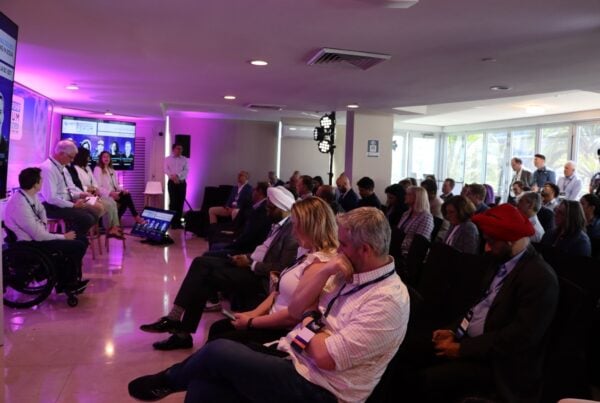Mobile advertising is big. But it could be even bigger with the addition of more reliable data sets. Can MNOs provide them? In a MEF Connects Digital webinar, three experts shared their stories…
If it’s true that the world is undergoing a data revolution, then advertising is doing it first.
Over the last decade, the momentum in advertising has moved from offline to digital and from digital to mobile. In the process, it has gone programmatic.
This has changed the fundamentals of the space. In the old world, advertisers would target a certain audience by running ads in places they hoped these customers might be: newspapers, TV programmes, bus stops.
Watch the MEF Connects Digital panel in full
So, if they wanted to reach fashionable 18 to 25 year old women, they might place ads in a glossy magazine.
Now, advertisers can target consumers directly. They can then show ads to her on wherever app or site she might happen to be visiting.
In this world, if a fashionable 23 year old female happens to be browsing a car parts mobile web site, she’ll still see ads for strapless dresses.
This granular level of ad targeting is only possible when brands can target users based on their behaviours, but do it in an anonymised manner that maintains consumer privacy. Typically, they do this with cookies. They can then track a person’s journey across the mobile web (or apps) and make ‘probabilistic’ assumptions about what kind of person they are.
Obviously. Google and Facebook are best placed to do this. They have far more data about people than any other participants in mobile.
However, advertisers would relish an alternative.
Can anyone else match Google/Facebook’s insight? Well, yes. Many organisations now own verifiable customer profiles, which they can combine with behavioural data. They can use this to power reliable customer targeting.
Mobile operators are a case in point. In fact, MNOs can deliver uniquely powerful data sets in the mobile space because they can match demographic data to the device and the number.
Two MEF members – zeotap and Cinarra – are at the heart of the push to make MNOs play in the mobile ad space. In last week’s MEF Connects Digital session – New Thinking on Telco Data and Mobile Advertising – we explored this issue further.
On my phone I might use the browser and an app and to most systems I will look like two or more different people. But with carrier data, you can build this data into something unified. You know this is one person, and that’s very valuable.”
The panel comprised:
- Florian Lichtwald, SVP Global Telecom Partnerships, zeotap
- Oliver Kanders – SVP Marketing & EMEA, zeotap
- Bill Leece, Vice President of Product Management, Cinarra
Here are the highlights
How can MNO data provide an mobile advertising alternative to Google/Facebook?
Bill Leece – “Facebook and Google are getting about 80 per cent of digital display ad budgets in the US because they have the eyeballs (across networks in the case of Google) and a walled garden (in the case of Facebook). Google can stitch together data about consumer interests from searches and site visits.
“But mobile carriers have important data assets too – especially location data. That means they can infer information about someone not just from the sites they visit but also the places they go.”
Florian Lichtwald – “A carrier can verify its socio-demographic data on its users. We can look at app usage and browsing data. This is unique. Not even Google can offer that. Operators control the gateway. They can see the entire traffic when a person is on mobile. Others get bits and pieces.
“And there’s another opportunity in identity. Telcos can connect cookies to advertising IDs, but also map them to email and phone numbers. There’s a real lack of this in the online world.”
Bill Leece – “And we can bring together these identifiers. So, for example, on my phone I might use the browser and an app and to most systems I will look like two or more different people. But with carrier data, you can unify this data and build it into something unified. You know this is one person, and that’s very valuable.”
Why is MNO data better at location analytics?
Bill Leece – “Traditional location advertising targeted consumers based on their current location. This is interesting, but historical location data is more useful. So, if you are targeting mothers of young children, you might analyse the time women between 25 and 40 spent at parks during the work week. We can take this data and merge it with the first party data we have, so we don’t have to build a probabilistic model.
“Using 4G and wifi data gives us more precision than GPS. Wifi measurements are accurate indoors and can differentiate by elevation. This is important. It might be that on a multi-level shopping mall there’s a restaurant on the third floor and a place that sells strollers on the fifth, for example. With streaming wifi data we can differentiate between venue visits to these two very different types of venues.”
We are applying GDPR standards across the world. It’s the the way to go – a global trend. You can see this in recently passed laws in California and India. We also use ISO/IEC 27001 Information Security Management standards for hashing and encryption to de-identify any data.”
How can telco data help to tackle ad fraud?
Oliver Kanders – “It can address bot traffic. Video is now a huge part of mobile advertising, and viewability is the key metric. Advertisers pay depending on how long has someone viewed. With our data, we can certify that traffic to show it is made up of real people and is not coming from a bot farm somewhere.”
Bill Leece – “In programmatic advertising brands will pay more for some users that others. They might pay more for users in California than Kansas, for example. This incentivises some publishers to lie about the source location of traffic. With verified identities and high quality, streaming mobile operator location data, we can address this to both detect and prevent this kind of fraud.”
Is there an opportunity to apply telco data beyond advertising?
Florian Lichtwald – “We’re looking at training AI algorithms. Companies need great data with which to train their AI. There’s an opportunity there.”
How can you maintain consumer trust avoid the ‘creepy’ factor in programmatic advertising?
Florian Lichtwald – “We are applying GDPR standards across the world. It’s the way to go – a global trend. You can can see this in recently passed laws in California and India. We also use ISO/IEC 27001 Information Security Management standards for hashing and encryption to de-identify any data.
“In the end, brands really don’t want to annoy users. They’re afraid of it. So they can do things like set frequency caps, where users only see an ad once a week for example.”
Bill Leece – “This is another area where having verifiable carrier identities helps. When you have multiple cookie IDs, these frequency caps don’t work so well because the system might think one user is many people. With frequency capping done at a device ID level, you can ensure the ad is only served to a consumer as required by the advertiser.”
Register Now for the next MEF Connects Digital – October 17
The introduction of GDPR regulation in Europe has spurred a global debate on privacy. But the global regulation is still very fragmented and diverse outside of EU. Recently Brazil has revamped its data privacy law, a framework that many consider harmonized to GDPR in spirit and structure.
Join Rafael Pelon, Partner at FAS Advogados for a 360 view on the new approach to Data Privacy in Brazil and the outlook for the rest of Latin America.







